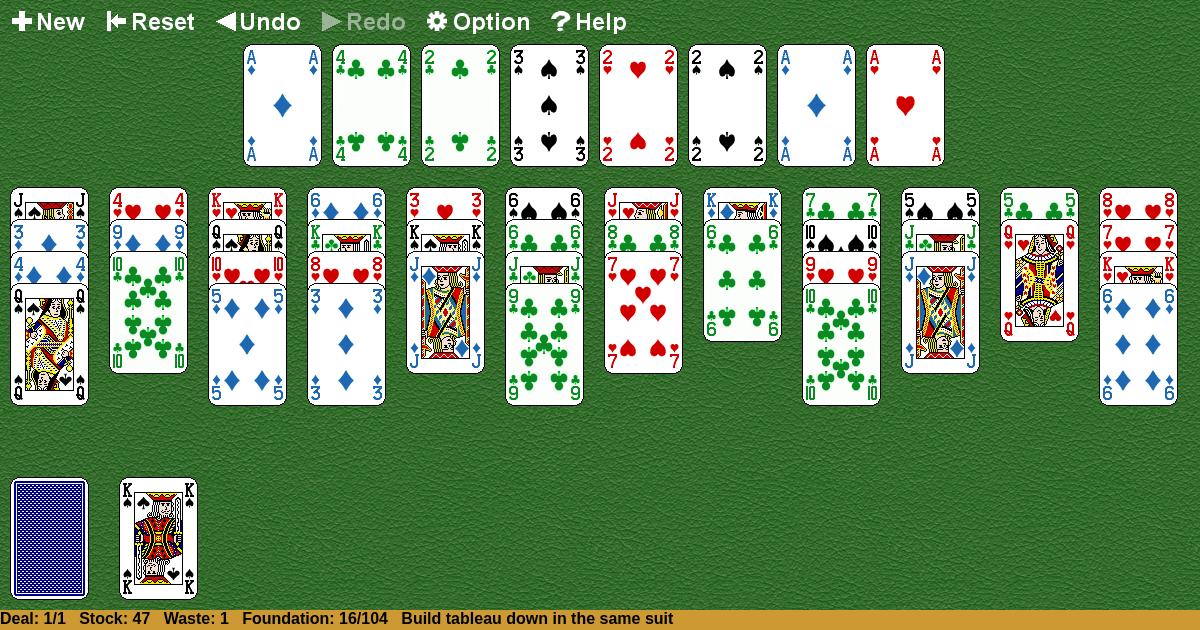Napoleon's Quadrilateral
Home |
How to play |
FAQ |
About
How to play Napoleon's Quadrilateral?
Game Objective:
The primary goal in Napoleon's Quadrilateral Solitaire is to move all cards from the tableau and stock to the foundation piles, building each foundation up in suit from Ace to King.
Setup & Layout:
- Deck: Use two standard 52-card decks (total 104 cards).
- Tableau: Deal twelve tableau piles, each with four cards, arranged to form three sides of a square (the “quadrilateral”). All cards in the tableau are dealt face up.
- Foundations: The fourth side of the square is reserved for eight foundation piles, which will be built up in suit starting from Aces as they become available.
- Stock: The remaining cards (after tableau setup) form the stock pile, placed aside face down.
- Waste: Cards from the stock that cannot be played immediately are placed face up on the waste pile; only the top card of the waste is available for play.
- Key Play Areas:
- Tableau: Twelve piles, four cards each, all face up.
- Foundations: Eight empty piles, to be filled as Aces appear.
- Stock: Face-down pile for drawing new cards.
- Waste: Face-up pile for discarded stock cards.
Napoleon's Quadrilateral Solitaire Rules:
- Foundations: Build up in suit from Ace to King. Any Ace may be moved to any empty foundation pile as soon as it becomes available.
- Tableau Building: Build tableau piles down in suit. Both single cards and sequences of cards in correct descending suit order may be moved as a unit between tableau piles.
- Available Cards: Only the top card of each tableau pile and the top card of the waste pile are available for play.
- Moving Cards:
- Cards may be moved from tableau to foundation if they are the next in suit.
- Cards may be moved between tableau piles, provided they follow descending suit order.
- Sequences of cards in descending suit order may be moved together.
- Spaces: When a tableau pile becomes empty, it can be filled with any available card or sequence.
Gameplay:
- Player Actions:
- Move available cards from tableau or waste to foundations if possible.
- Move available cards or sequences between tableau piles, following descending suit order.
- When no more moves are available, draw one card at a time from the stock and place it on the waste pile.
- Only the top card of the waste pile is available for play.
- Introducing New Cards:
- Cards are introduced into play by drawing from the stock to the waste pile.
- Any card drawn from the stock may be played to the foundation or tableau if legal; otherwise, it remains on the waste pile.
- No More Moves:
- If no legal moves are possible and the stock is exhausted, the game ends.
Winning & Losing Conditions:
- Winning Condition: The game is won when all cards are successfully built onto the eight foundation piles, each completed from Ace to King in suit.
- Losing Condition: The game is lost (or unwinnable) if the stock is exhausted and no further legal moves can be made to transfer cards to the foundations.
Special Rules & Edge Cases:
- Filling Spaces: Any empty tableau pile may be filled with any available card or sequence, not restricted to Kings.
- Sequence Moves: Groups of cards in descending suit order may be moved together between tableau piles.
- Stock & Waste: The stock is dealt only once; there is no redeal.
- Foundation Flexibility: Any Ace may start any foundation pile; there is no restriction on suit placement for initial foundation setup.
- Edge Case: If a tableau pile is emptied and no available cards remain to fill it, the space remains empty until a legal move is possible.
Definitions:
- Tableau: The main play area of twelve piles where most card manipulation occurs.
- Foundation: The target piles where cards are built up in suit from Ace to King.
- Stock: The pile of undealt cards used to introduce new cards into play.
- Waste: The pile where unplayable stock cards are placed, with only the top card available for play.
This guide provides a precise breakdown of Napoleon's Quadrilateral Solitaire for optimal clarity and reference.

Solitaire Collection
About Napoleon's Quadrilateral
Rate (Napoleon's Quadrilateral)
4.7 / 5
1,916 votes



























































